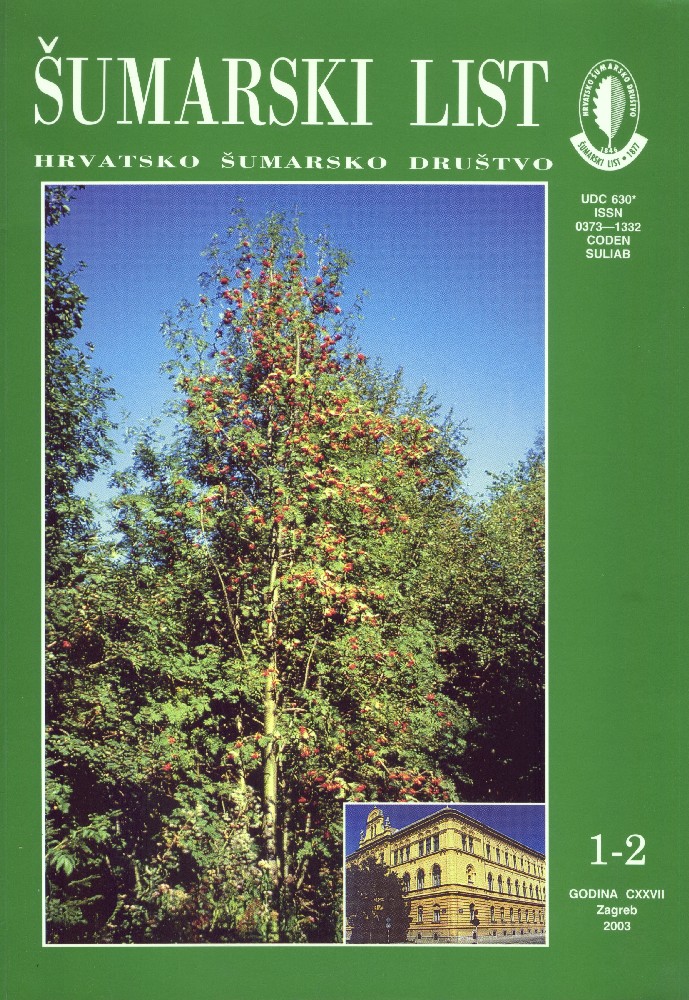
broj: 1-2/2003
pdf (21,5 MB) |
|
||||||||||||||
| IZVORNI ZNANSTVENI ČLANCI | ||
| Trinajstić, I., Franjić, J., Škvorc, Ž. | UDK 630* 188 (001) | |
| Syntaxonomic Analysis of the Beech Forests of Međimurje (Croatia) pdf HR EN | 3 | |
| Zelić, J. | UDK 630* 226 (001) | |
| The Problems of Management with Beech and Silver Fir Selection Forest (Abieti-Fagetum pannonicum Rauš 1969) in the Mountain Papuk pdf HR EN | 11 | |
| PRETHODNO PRIOPĆENJE | ||
| Vodolšak, M., Križaj, D. | UDK 630* 156 | |
| Game Loss and Damages from the Game in the Krapinsko-Zagorska County District pdf HR EN | 27 | |
| Prka, M. | UDK 630* 325 + 851 | |
| Value Characteristics of Common Beech Trees with Regard to the Type of Felling in the Cutting Areas of Bjelovar Bilogora pdf HR EN | 35 | |
| Summary: Research was carried on index values of trees with regard to breast diameter and the type of felling, whit the aim of getting information that could be used in forming databases for working our assortment tables. Research was been carried on 772 exemplary trees in 12 areas and 15 cuttings, of older and old beech stand of the management unit Bjelovar Bilogora. We analysed overall percentage deviation between planned and realized percentages of veneer logs, peeler logs and saw logs of 1st class in relation to the age of cutting area and the type of felling. The research included 70 common beech-cutting areas in the management unit Bjelovar Bilogora, of the age between 51 and 131 years, in the period of almost three years. Dependence was established of the index values of common beech trees on the diameter class and the type of felling. Lover index trees values of spacing and preparatory felling in relation to index values of the trees seeding and final felling, point to lower-quality assortment structure within an individual diameter class in spacing and preparatory felling. These differences are results of the selection criteria for cutting down trees (marking trees) we employ to carry out the required type of felling. Among practical values of the research results, we can point out the possibility of decreasing the sample size while forming databases necessary for working out assortments tables that would take into account the type of felling as one of inputs. Analysis of the overall deviation between planned and realized percentage of the highest quality timber assortments in cutting areas, points to considerable differences in particular timber assortments and type of felling. It is suggested that in working out future assortment tables (according to European standards), one of the inputs should be the type of felling, including preliminary examination of the relation of timber assortments to the type of felling characteristic for this method. Key words: common beech felling; quality of trees; assortment structure; assortment tables; index values of common beech trees | ||
| PREGLEDNI ČLANCI | ||
| Franjić, J., Pandža, M., Škvorc, Ž. | UDK 630* 181.1 (Anthyllis barba-jovis L.) | |
| Distribution of Anthyllis barba-jovis L. (Fabaceae) in Croatia pdf HR EN | 45 | |
| STRUČNI ČLANCI | ||
| Farkaš-Topolnik, N., Krauthacker, H., Trenc, N. | UDK 630* 907.1 | |
| International Conference "Protected Areas of European Mountains - Place of Life Recreation and Exchange", Chambery, France pdf HR EN | 51 | |


